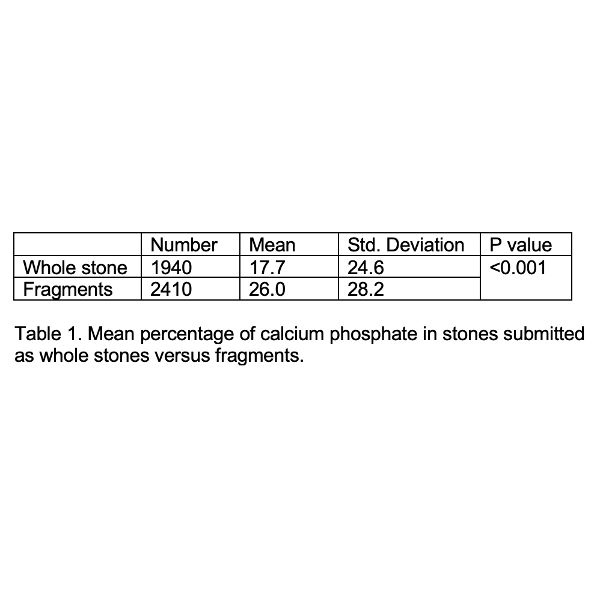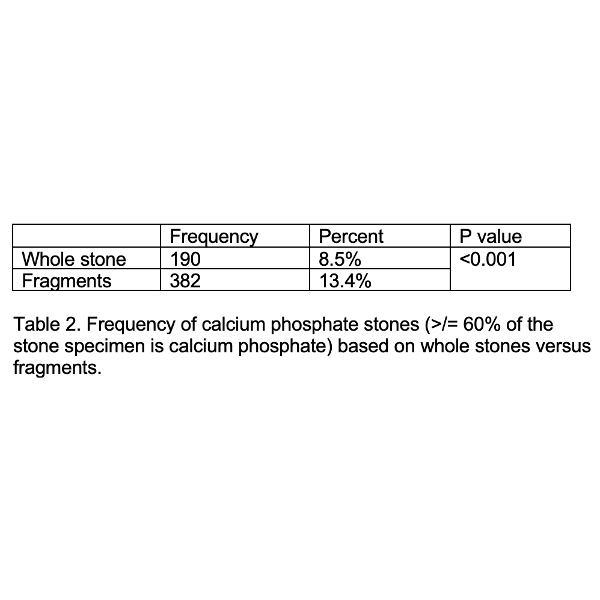Back
Poster, Podium & Video Sessions
Moderated Poster
MP26: Stone Disease: Epidemiology & Evaluation I
MP26-11: Calcium Phosphate Stone Composition Varies Based on Whether Stone Analyses are Whole Stones versus Stone Fragments
Saturday, May 14, 2022
10:30 AM – 11:45 AM
Location: Room 225
Margaret Knoedler*, Shuang Li, Stephen Nakada, Sara Best, Sean Hedican, Kristina Penniston, Madison, WI

Margaret Knoedler, MD
University of Wisconsin
Poster Presenter(s)
Introduction: Stone analysis is a cornerstone of metabolic stone treatment. Our objective was to evaluate if the prevalence of calcium phosphate in stone composition varied based on whether the specimen was submitted as a whole stone or as fragments of a stone.
Methods: An IRB approved surgical database of patients at a single institution was evaluated for stone analyses between 1997 and August 2021. All stone analyses were performed at one of two labs (Dianon Systems and Louis C. Herring Company). Stone analyses were assessed for presence and percent of any calcium phosphate species. Stones were considered primarily calcium phosphate stones if the composition was >/= 60% calcium phosphate. We used univariate analysis with chi-square and independent T test to compare percentage of stone specimens submitted as calcium phosphate as well as frequency of primarily calcium phosphate stones submitted as whole stones versus fragments.
Results: Of the 5069 stone specimens analyzed, 4350 specimens contained any amount of calcium phosphate and 572 were primarily calcium phosphate stones. When comparing all specimens containing calcium phosphate submitted as whole stones versus fragments of stones, there was a statistical difference between the percent of specimen that was calcium phosphate (17.7±24.6% vs 26.0±28.2%, p<0.001). See table 1. For primarily calcium phosphate stones, the frequency of stones submitted as whole stones versus fragments also differed significantly (8.5% vs 13.4%, p<0.001). See table 2.
Conclusions: In our analysis, the frequency and percentage of calcium phosphate composition differed when samples were submitted as fragments versus whole stones. Specimens submitted as fragments had a higher frequency and percentage of calcium phosphate than specimens submitted as whole stones. Knowing the percentage of calcium phosphate in patients’ stones is vital in correctly identifying the patient’s stone phenotype and developing a preventive regimen. Other ongoing considerations include the value of repeated stone analysis in these patients.
Source of Funding: None


Methods: An IRB approved surgical database of patients at a single institution was evaluated for stone analyses between 1997 and August 2021. All stone analyses were performed at one of two labs (Dianon Systems and Louis C. Herring Company). Stone analyses were assessed for presence and percent of any calcium phosphate species. Stones were considered primarily calcium phosphate stones if the composition was >/= 60% calcium phosphate. We used univariate analysis with chi-square and independent T test to compare percentage of stone specimens submitted as calcium phosphate as well as frequency of primarily calcium phosphate stones submitted as whole stones versus fragments.
Results: Of the 5069 stone specimens analyzed, 4350 specimens contained any amount of calcium phosphate and 572 were primarily calcium phosphate stones. When comparing all specimens containing calcium phosphate submitted as whole stones versus fragments of stones, there was a statistical difference between the percent of specimen that was calcium phosphate (17.7±24.6% vs 26.0±28.2%, p<0.001). See table 1. For primarily calcium phosphate stones, the frequency of stones submitted as whole stones versus fragments also differed significantly (8.5% vs 13.4%, p<0.001). See table 2.
Conclusions: In our analysis, the frequency and percentage of calcium phosphate composition differed when samples were submitted as fragments versus whole stones. Specimens submitted as fragments had a higher frequency and percentage of calcium phosphate than specimens submitted as whole stones. Knowing the percentage of calcium phosphate in patients’ stones is vital in correctly identifying the patient’s stone phenotype and developing a preventive regimen. Other ongoing considerations include the value of repeated stone analysis in these patients.
Source of Funding: None



.jpg)
.jpg)